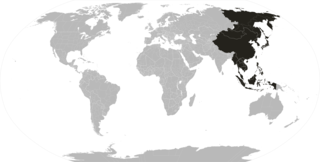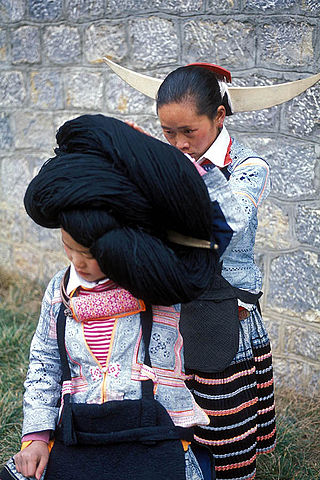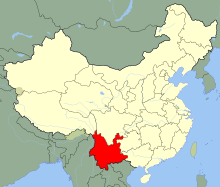
The Far East is the geographical region that encompasses the easternmost portion of the Asian continent, including East, North, and Southeast Asia. In modern times, the term Far East has widely fallen out of use and been substituted by Asia–Pacific, while the terms Middle East and Near East, although now pertaining to different territories, are still commonly used today.

The history of Southeast Asia covers the people of Southeast Asia from prehistory to the present in two distinct sub-regions: Mainland Southeast Asia and Maritime Southeast Asia. Mainland Southeast Asia comprises Cambodia, Laos, Myanmar, Peninsular Malaysia, Thailand and Vietnam whereas Maritime Southeast Asia comprises Brunei, Cocos (Keeling) Islands, Christmas Island, East Malaysia, East Timor, Indonesia, Philippines and Singapore.

The Silk Road was a network of Eurasian trade routes active from the second century BCE until the mid-15th century. Spanning over 6,400 km (4,000 mi), it played a central role in facilitating economic, cultural, political, and religious interactions between the Eastern and Western worlds. The name "Silk Road" was first coined in the late 19th century, but some 20th- and 21st-century historians instead prefer the term Silk Routes, on the grounds that it more accurately describes the intricate web of land and sea routes connecting Central, East, South, Southeast, and West Asia as well as East Africa and Southern Europe.

Yunnan is an inland province in Southwestern China. The province spans approximately 394,000 km2 (152,000 sq mi) and has a population of 48.3 million. The capital of the province is Kunming. The province borders the Chinese provinces of Guizhou, Sichuan, autonomous regions of Guangxi and Tibet, as well as Southeast Asian countries Myanmar (Burma), Vietnam, and Laos. Yunnan is China's fourth least developed province based on disposable income per capita in 2014.

The Orient is a term referring to the East in relation to Europe, traditionally comprising anything belonging to the Eastern world. It is the antonym of the term Occident, which refers to the Western world.

The Tibetan people are an East Asian ethnic group native to Tibet. Their current population is estimated to be around 6.7 million. In addition to the majority living in Tibet Autonomous Region of China, significant numbers of Tibetans live in the Chinese provinces of Gansu, Qinghai, Sichuan, and Yunnan, as well as in India, Nepal, and Bhutan.

The Miao are a group of linguistically related peoples living in Southern China and Southeast Asia, who are recognized by the government of China as one of the 56 official ethnic groups. The Miao live primarily in the mountains of southern China. Their homeland encompasses the provinces of Guizhou, Yunnan, Sichuan, Hubei, Hunan, Guangxi, Guangdong, and Hainan. Some sub-groups of the Miao, most notably the Hmong people, have migrated out of China into Southeast Asia. Following the communist takeover of Laos in 1975, a large group of Hmong refugees resettled in several Western nations, mainly in the United States, France, and Australia.

Maritime Southeast Asia comprises the countries of Brunei, Indonesia, Malaysia, the Philippines, Singapore, and East Timor.

Thai people are a Southeast Asian ethnic group native to Thailand. In a narrower and ethnic sense, the Thais are also a Tai ethnic group dominant in Central and Southern Thailand. Part of the larger Tai ethno-linguistic group native to Southeast Asia as well as Southern China and Northeast India, Thais speak the Sukhothai languages, which is classified as part of the Kra–Dai family of languages. The majority of Thais are followers of Theravada Buddhism.

Dian was an ancient kingdom established by the Dian people, a non-Han metalworking civilization that inhabited around the Dian Lake plateau of central northern Yunnan, China from the late Spring and Autumn period until the Eastern Han dynasty. The Dian buried their dead in vertical pit graves. The Dian language was likely one of the Tibeto-Burman languages. The Han Empire's annexation of the Dian Kingdom in 109 BCE eventually led to the establishment of the Yizhou commandery. Dian culture started from at least the 8th century BCE, until it fell under the control of the Han dynasty in 109 BCE.

Hinduism is currently practiced by a minority of residents of China. The religion itself has a very limited presence in modern mainland China, but archaeological evidence suggests a significant presence of Hinduism in different provinces of medieval China. Hindu influences were also absorbed in to Buddhism and got mixed with Chinese mythology over its history. Practices originating in the Vedic tradition of ancient India such as yoga and meditation are also popular in China.

Southwestern China is a region in the south of the People's Republic of China.
The illegal drug trade in China is influenced by factors such as history, location, size, population, and current economic conditions. China has one-sixth of the world's population and a large and expanding economy. China's large land mass, close proximity to the Golden Triangle, Golden Crescent, and numerous coastal cities with large and modern port facilities make it an attractive transit center for drug traffickers. Opium has played an important role in the country's history since before the First and Second Opium Wars in the mid-19th century.

The People's Republic of China (PRC) shares land borders with 14 countries : North Korea, Russia, Mongolia, Kazakhstan, Kyrgyzstan, Tajikistan, Afghanistan, Pakistan, India, Nepal, Bhutan, Myanmar, Laos, and Vietnam. The land borders, in counterclockwise order from northeast to southwest, include the China–North Korea border, the eastern segment of the China–Russia border, the China–Mongolia border, the western segment of the China–Russia border, the China–Kazakhstan border, the China–Kyrgyzstan border, the China–Tajikistan border, the China–Afghanistan border, the China–Pakistan border, the western segment of the China–India border, the China–Nepal border, the central segment of the China–India border (Sikkim), the China–Bhutan border, the eastern segment of the China–India border, the China–Myanmar border, the China–Laos border, the China–Vietnam border. In addition, there is a 30-kilometre (19 mi) internal border with the special administrative region of Hong Kong, which was a British dependency before 1997, and a 3-kilometre (1.9 mi) internal border with Macau, a Portuguese territory until 1999.

East Asia is a geographical and cultural region of Asia including the countries of China, Japan, Mongolia, North Korea, South Korea, and Taiwan. Additionally, Hong Kong and Macau are the two Special Administrative Regions of China. The economies of China, Japan, South Korea, and Taiwan are among the world's largest and most prosperous. East Asia borders Siberia and the Russian Far East to the north, Southeast Asia to the south, South Asia to the southwest, and Central Asia to the west. To its east is the Pacific Ocean.

The ancestral population of modern Asian people has its origins in the two primary prehistoric settlement centres – greater Southwest Asia and from the Mongolian plateau towards Northern China.

The Indian subcontinent is a physiographical region in Southern Asia, mostly situated on the Indian Plate, projecting southwards into the Indian Ocean from the Himalayas. Geographically, it spans the countries of Bangladesh, Bhutan, the British Indian Ocean Territory, India, Maldives, Nepal, Pakistan, and Sri Lanka. Although the terms "Indian subcontinent" and "South Asia" are often used interchangeably to denote the region, the geopolitical term of South Asia frequently includes Afghanistan, which is not considered a part of the subcontinent, while excluding the British Indian Ocean Territory which is geologically associated with the subcontinent.Apart from Maritime Southeast Asia, littoral region of Indian subcontinent or littoral South Asia, is the only subregion of Asia that lies partly within the Southern Hemisphere: the British Indian Ocean Territory and two out of 26 atolls of Maldives lie entirely within the Southern Hemisphere.

The Tibeto-Burman languages are the non-Sinitic members of the Sino-Tibetan language family, over 400 of which are spoken throughout the Southeast Asian Massif ("Zomia") as well as parts of East Asia and South Asia. Around 60 million people speak Tibeto-Burman languages. The name derives from the most widely spoken of these languages, Burmese and the Tibetic languages, which also have extensive literary traditions, dating from the 12th and 7th centuries respectively. Most of the other languages are spoken by much smaller communities, and many of them have not been described in detail.

Pacific Asia is the region along the east coast of Asia bordering the western Pacific Ocean. It constitutes most of East Asia, Northeast Asia, and Southeast Asia.

The first phase of European colonisation of Southeast Asia took place throughout the 16th and 17th centuries. Where new European powers competing to gain monopoly over the spice trade, as this trade was very valuable to the Europeans due to high demand for various spices such as pepper, cinnamon, nutmeg, and cloves. This demand led to the arrival of Portuguese, Spanish, Dutch, French, and British marine spice traders. Fiercely competitive, the Europeans soon sought to eliminate each other by forcibly taking control of the production centres, trade hubs and vital strategic locations, beginning with the Portuguese acquisition of Malacca in 1511. Throughout the 17th and 18th centuries, conquests focused on ports along the maritime routes, that provided a secure passage of maritime trade. It also allowed foreign rulers to levy taxes and control prices of the highly desired Southeast Asian commodities. By the 19th century, all of Southeast Asia had been forced into the various spheres of influence of European global players except Siam, which had served as a convenient buffer state sandwiched between British Burma and French Indochina. The kings of Siam had to contend with repeated humiliations, accept unequal treaties among massive French and British political interference and territorial losses after the Franco-Siamese crisis of 1893 and the Anglo-Siamese Treaty of 1909.


















